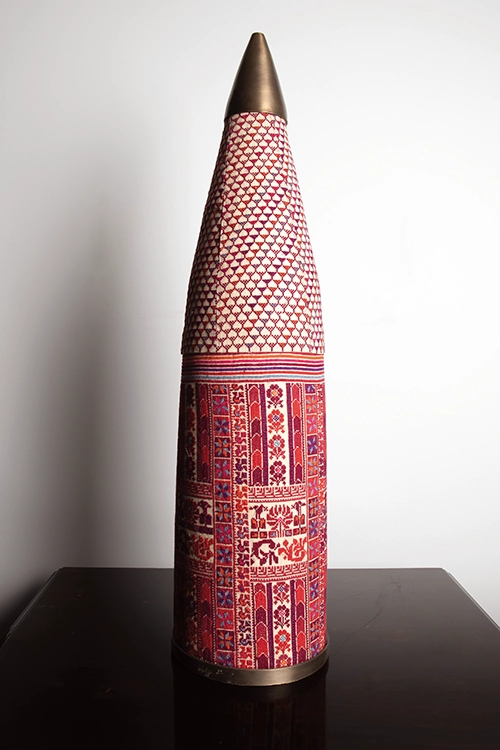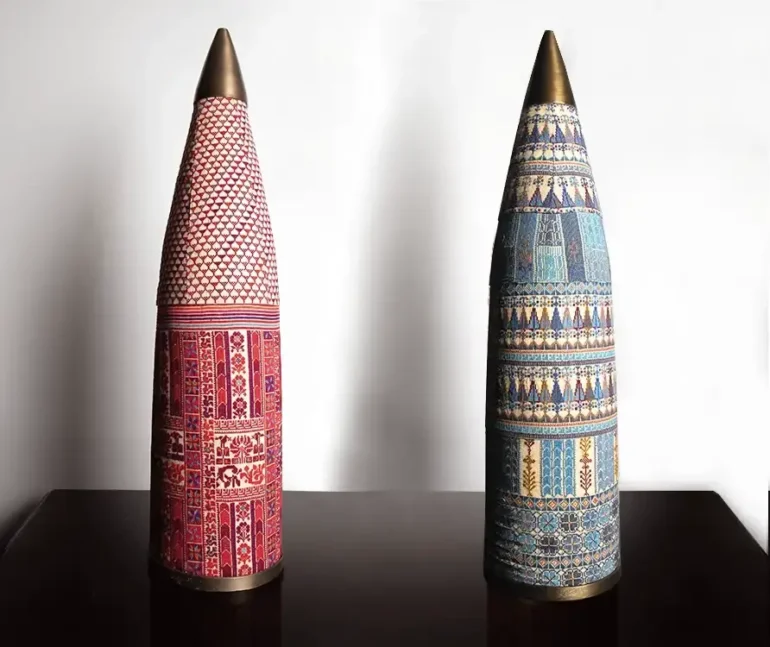In the spirit of connection
An exhibition at Sharjah’s Maraya Art Centre showcases tatreez as a powerful aesthetic force.
By Anna Seaman


Lebanese artist Katya Traboulsi presents two mortar missile sculptures covered in embroidery made by Inaash. They are part of her Perpetual Identities series. Courtesy of the artist and Maraya Art Centre.
The unwoven threads in Areen Hassan’s work hold almost as much significance as their embroidered counterparts. The gaps between them signify the growing distance between the Palestinian people and their land, but also the enduring connection.
Hassan is featured in SILA: All That’s Left to You, a group exhibition with over 25 artists and designers at Sharjah’s Maraya Art Centre that explores the ancient Palestinian cross-stitch embroidery tradition known as tatreez through contemporary practices. The poignant subtitle is borrowed from Ghassan Kanafani’s landmark 1966 novella, a meditation on loss and the fragments of identity that persist. In the same spirit, SILA asks: What stories and traditions remain and how can they be carried forward?
Curated by Cima Azzam (Maraya Art Centre) and Noor Suhail (1971—Design Space), the exhibition, which runs until January, invites contemporary artists and designers to engage with the language of tatreez through paintings, sculptures, textiles, and multimedia. The works are emotionally charged. Tatreez is an act of survival and cultural resilience, Suhail says.
Hassan merges Palestinian embroidery with silkscreen printing, deliberately leaving parts of her textiles unravelled. The pieces feel both fragile and strong, with each thread representing the Palestinian people: broken, yet whole; fragmented, yet beautiful.
Hassan’s works, commissioned by Maraya Art Centre for this exhibition, were created in collaboration with master embroiderers from the Beirut-based Inaash Association, founded by Rula Alami to preserve Palestinian embroidery and support women artisans in refugee communities. Inaash’s role is central to SILA—the majority of the works were developed in dialogue between contemporary artists and these skilled embroiderers, whose deep knowledge of stitch, pattern, and regional tradition grounds the entire project. “It is through this lens that the exhibition unfolds,” Alami says, “where artisans, artists, designers, and curators form a harmonious chorus, presenting striking multimedia works that centre tatreez as a powerful aesthetic force.”
“Tatreez is a centuries-old heritage,” says Azzam. “It is important to celebrate the richness and depth of Palestinian culture. So many people are connected to this land, even if they are far from it now. We hope this exhibition offers a way to celebrate those stories, not only to safeguard history but to create space for something positive.”
Throughout SILA, thread becomes a metaphor for continuity, resistance, and endurance. Abdul Rahman Katanani’s monumental weavings of barbed wire and metal reference traditional tatreez patterns, their industrial materials transformed with unexpected delicacy. Amer Shomali reflects on an unworn Palestinian wedding dress in a poetic installation of yarn and memory. Aya Haidar’s floor cushions are densely embroidered with symbols such as Jaffa oranges, olive branches, and cedar, and stuffed with zaatar. They evoke vivid, sensorial memories.



